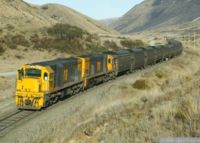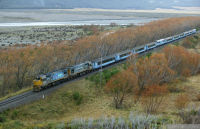List of NZ railfan jargon
From TrainSpottingWorld, for Rail fans everywhere
File:Flyingtomato.jpg
Flying tomato livery. Standard NZGR livery has gray on the cab sides instead of orange.
File:DC4369atNewmarket.jpg
Auckland's MAXX Blue livery.
File:EF30163+Overlander NearWaiouru 22March2003 JChristianson.jpg
Almost all of the "Toasters" are painted in the International Orange livery.
File:Tollnz DAR.jpg.jpg
DAR 517 in Toll Rail colours.
This is a list of jargon commonly used by railfans in New Zealand.
Contents: Top - 0–9 A B C D E F G H I J K L M N O P Q R S T U V W X Y Z
A
- Articulateds: NZR RM class 88 seater railcars.[1]
B
- Blue Streaks: Three NZR RM class 88 seater railcars renovated for a fast service between Hamilton and Auckland.[1][2]
- Bumble-Bee: Yellow and black Tranz Rail livery.
C
- Clockwork Orange: 1970s orange and yellow livery; used on DX class (also known as "Tropical" or "Popsicle").[3]
- Corn-cob: Toll Rail yellow and aquamarine livery
- Cyclops: restored Wellington EMU set DM 556.[4]
D
- Dixie: A DX class locomotive.
- Drewrys: NZR RM class 88 seater railcars.
E
- 'En and chicken: N and M class steam locomotives working in multiple. 'En, an abbreviation of 'hen', refers to the larger N class locomotive, and chicken refers to its underpowered M class assistant.[5]
F
- Fiats: NZR RM class 88 seater railcars.[1]
- Flying Tomato: Simpler version of the Fruit Salad livery, with grey replaced with red
- Fruit Salad: NZR red and grey livery with yellow highlights, also known as International Orange
G
- Grass Grub: 88 seater railcars that were converted to de-motorised carriages for locomotive haulage. Their name came from their green livery.[2]
- Gull Roost: The Onerahi Branch's 323 metre long bridge across the harbour in Whangarei. Named due to the large amount of gulls that roosted on the bridge. The branch closed in 1933 and the bridge no longer exists.[6]
H
- The Hill: The Johnsonville line out of Wellington, or the steep section of the North Auckland Line between Newmarket and Remuera in Auckland.
- Hot water bottle: a steam heating van used to warm the carriages of passenger trains.Cite error: Closing
</ref>missing for<ref>tag
J
- Jigger - Common slang name for a (motor) section car, elsewhere known as a trike, trolley, quad or Speeder
K
- KB country: the section of the Midland Line between Springfield and Arthur's Pass famous for the use of KB class steam locomotives between 1939 and 1968.[7][8]
L
- Longest xylophone in the world: former road/rail bridge on the now-closed portion of the Ross Branch south of Hokitika, named for the loud rattling its planks made.[9]
M
- MAXX Blue: The livery used on Auckland rolling stock operated on MAXX services by Veolia.
- Midland Red: Name for the red livery used between the 1920s and 1990s on passenger carriages, NZR DM class electric multiple units, and some other rolling stock. It was first trialled on the carriages of the Parnassus Express, the predecessor of the Picton Express. Its name derives from the London, Midland and Scottish Railway, from whom the colour was originally sourced.
N
O
- Old reds: DM/D class electric multiple units in their traditional red livery.[10]
- Over the hill refers to a train using the Auckland - Newmarket Line and the North Auckland Line through Auckland to access or depart from Britomart instead of using the far north section of the North Island Main Trunk Railway. The hill referred to by the phrase is the steep section between Newmarket and Remuera stations.
P
File:E66 Petone Workshops 1906.JPG
"Pearson's Dream" just after it was completed in February 1906.
- Pearson's Dream: E 66, nicknamed after its designer, G. A. Pearson, as it did not fulfill his ambitions.[11]
- The Pig: DXR class locomotive 8007.
- Popsicle: 1970s orange and yellow DX class livery
- Pullet: M class, named for their lack of pulling power in comparison to other classes.[5]
Q
R
- The racetrack: The Main South Line near Rakaia where steam-hauled passenger express trains attained high speeds.[12]
- Rat hole: Either the Otira Tunnel or the now-disused Karangahake Gorge tunnel on the East Coast Main Trunk Railway's former Waihi route. Sometimes abbreviated to "the Hole".
- Red Set: Three-car English Electric DM/D sets allocated to Tranz Metro Wellington.
- Red Terror: A Leyland Cub car converted to run on rails for inspection use by the Railways Department General Manager Garnet Hercules Mackley in 1933. It was converted for uses associated with electrified lines in 1941, and after spending a few years in the Hutt Valley, it was transferred to Otira and remained there until the Otira Tunnel was de-electrified in the 1990s. It is now owned by the Ferrymead Railway.[13]
- Rimutaka railcars: Alternative name for the Wairarapa railcars, derived from the fact they were built to operate on the Rimutaka Incline.
S
- Skippy: Alternative name for a Toll-liveried locomotive. The name is dervied from Skippy the Bush Kangaroo as Toll is an Australian company.
T
- Tin Hare: Wairarapa railcars.[14]
- Toasters: NZR EF class - so called due to their kitchen toaster-like appearance.
- Tonka Toy: Name given to preserved TR class locomotive TR 534.
- The Twins: DBR class locomotives 1200 and 1267, two Wellington-based locomotives that are commonly paired together and used for purposes such as banking south of Paekakariki.
- Twinsets: NZR RM class 88 seater railcars.[1]
U
V
W
X
Y
Z
See also
References
- ↑ 1.0 1.1 1.2 1.3 David Jones, Where Railcars Roamed: The Railcars Which Have Served New Zealand Railways (Wellington: Wellington Tramway Museum, 1997), 22.
- ↑ 2.0 2.1 Eric Heath and Bob Stott, Classic Railcars, Electric and Diesel Locomotives of New Zealand: Volume Two (Grantham House: Wellington, 1993), 34.
- ↑ Geoffrey B. Churchman and Tony Hurst, The Railways of New Zealand: A Journey Through History (Auckland: HarperCollins, 1991), 58.
- ↑ Department of Conservation, "Awards honour efforts to protect our cultural and natural heritage", published 10 August 2006, accessed 22 January 2008.
- ↑ 5.0 5.1 Churchman and Hurst, The Railways of New Zealand, 144.
- ↑ hurchman and Hurst, The Railways of New Zealand, 100.
- ↑ Churchman and Hurst, The Railways of New Zealand, 189.
- ↑ New Zealand Film Unit, KB Country, 1968.
- ↑ Churchman and Hurst, The Railways of New Zealand, 193.
- ↑ Heath and Stott, Classic Railcars, Electric and Diesel Locomotives, 20.
- ↑ W. N. Cameron, Rimutaka Incline: Extracts from "A Line of Railway" (Wellington: New Zealand Railway and Locomotive Society, 1992), 83.
- ↑ Churchman and Hurst, The Railways of New Zealand, 179.
- ↑ Jones, Where Railcars Roamed, 13.
- ↑ Jones, Where Railcars Roamed, 14.


